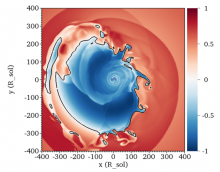
Abstract
We analyze a 3D hydrodynamic simulation of common envelope evolution to understand how energy is transferred between various forms, leading to the partial unbinding of the envelope. We find that 13-14% of the envelope is unbound during the simulation. Virtually all of the unbinding occurs before the end of the rapid plunge-in phase, here defined to coincide with the first periastron passage. In contrast, the total envelope energy is nearly constant during this time because positive energy transferred to the gas is counterbalanced by the negative binding energy from the closer proximity of the inner layers to the plunged-in secondary. During the subsequent slow spiral-in phase, energy continues to transfer to the envelope from the red giant core and secondary core particles. In our analysis, we critically assess the commonly used αCE-energy formalism, and suggest an alternative that more cleanly separates core particles and gas. Applying this formalism, we discuss that overcoming current limitations of existing simulations with respect to both the accessible parameter regime and the giant model may enable complete envelope ejection from orbital evolution even without new energy sources. We also propose that relative motion between the centre of mass of the envelope and the centre of mass of the particles could account for the offsets of planetary nebula central stars from the nebula's geometric centre.